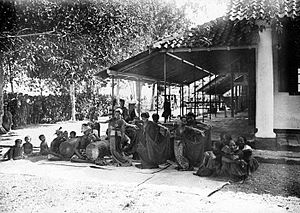The Bonerate people are an ethnic group in South Sulawesi, Indonesia. They inhabit around the Selayar island group such as Bonerate, Madu, Kalaotoa, and Karompa islands.[2]
 | |
| Total population | |
|---|---|
| 13,900[1] | |
| Regions with significant populations | |
| Languages | |
| Tukangbesi-Bonerate languages (Bonerate language), Indonesian language | |
| Religion | |
| Islam | |
| Related ethnic groups | |
| Butonese people |
Culture edit
The Bonerate people are generally Muslims.[3] Some traditional beliefs are still extant among the Bonerate.[4] Sexually provocative behaviour occurs in possession-trance ritual practiced by women only[5] and were carried out in a way by which they smother glowing embers with their bare feet at the climax of the ritual.[6] The Bonerate language is closely related to the language of the Tukang Besi islands off the southeast coast of Buton island.[7][8]
Many Bonerate are agriculturists, utilizing the slash-and-burn technique. Common crops grown include corn, cassava, several fruits like papaya and bananas and some vegetables like beans and peas. Some Bonerate also work as shipbuilders and sailors.[4]
References edit
- ^ "Bonerate in Indonesia". Joshua Project. Retrieved 2014-10-08.
- ^ "Bonerate". Ethnologue. Retrieved 2014-10-08.
- ^ Zulyani Hidayah (2015). Ensiklopedi: Suku bangsa di Indonesia. Yayasan Pustaka Obor Indonesia. p. 87. ISBN 978-97-946-1929-2.
- ^ a b Weekes, Richard V. (1984). Muslim Peoples [2 Volumes]: A World Ethnographic Survey. Bloomsbury Academic. p. 171. ISBN 978-0-313-23392-0.
- ^ Jeannette Mageo & Alan Howard (2012). Spirits in Culture, History and Mind. Routledge. ISBN 978-1-1367-5852-2.
- ^ "Crazy Women are Performing in Sombali": A Possession-Trance Ritual on Bonerate, Indonesia Author(s): Harald Beyer BrochSource: Ethos, Vol. 13, No. 3 (Autumn, 1985), pp. 262-282
- ^ James N. Sneddon & René van den Berg (1989). Studies in Sulawesi linguistics, Part 1. Badan Penyelenggara Seri Nusa, Universitas Katolik Indonesia Atma Jaya. p. 14. OCLC 470766997.
- ^ Charles E. Grimes, ed. (2000). Spices from the East: Papers in Languages of Eastern Indonesia. Pacific Linguistics. p. 55. ISBN 08-588-3460-X.